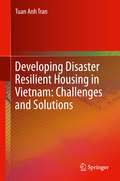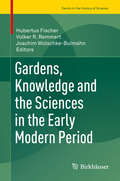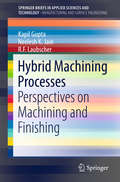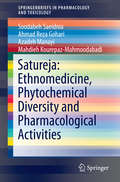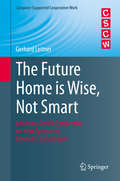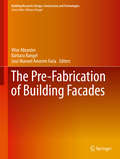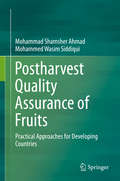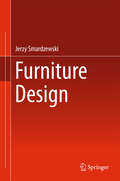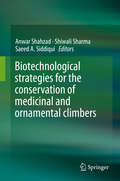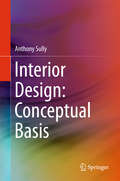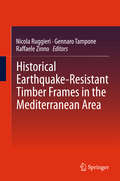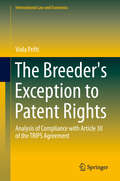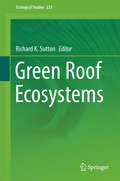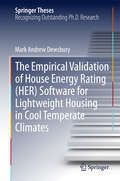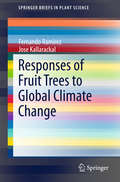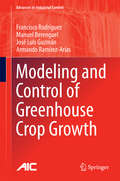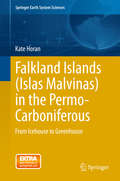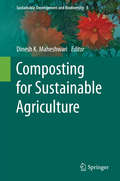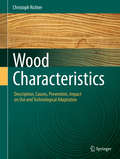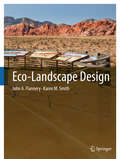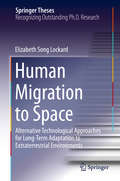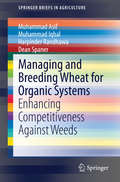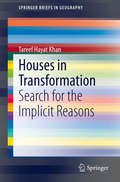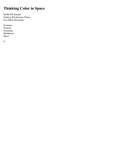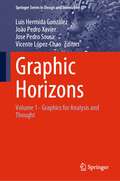- Table View
- List View
Developing Disaster Resilient Housing in Vietnam: Challenges and Solutions
by Tuan Anh TranThis book provides a comprehensive understanding on disaster resilient housing within the Vietnam context particularly and the developing world generally. The book has identified the root causes of housing vulnerability, restrictions to safe housing development, concepts of disaster resilient housing, key issues/factors implementers and building designers need to consider, and ways of achieving resilient housing outcomes in actual design projects. The design and development of disaster resilient housing has been framed into three main themes: (i) community consultation, (ii) the role of built-environment professionals and (iii) design responses for resilience. To achieve these themes, there is a variety of contextual and intervening conditions that need to be addressed and met to provide an enabling environment for promoting disaster resilient housing. These three themes are among the most arguable issues in recent debates and discussions, academically and practically, regarding disaster risk reduction and safe housing development. In addition, this book also provides the evidence-based design framework for disaster resilient housing upon which design ideas and solutions for safe and resilient housing can be generated and shaped.
Gardens, Knowledge and the Sciences in the Early Modern Period
by Hubertus Fischer Volker R. Remmert Joachim Wolschke-BulmahnThis volume of proceedings primarily focuses on the outstanding contributions made by botany and the mathematical sciences to the genesis and development of early modern garden art and garden culture. The many facets of mathematical sciences and botany point to the increasingly "scientific" approach that was being adopted in garden art and garden culture in the early modern period. This development unfolds in interaction with philosophical, religious, political and social processes and beliefs. This volume strikingly shows that such processes are able to make use of the knowledge of nature manifested in gardens for various purposes. The conference that inspired this volume was jointly organized by the Leibniz Universität Hannover's Centre of Garden Art and Landscape Architecture (CGL) and the Bergische Universität Wuppertal's Interdisciplinary Centre for Science and Technology Studies (IZWT).
Hybrid Machining Processes
by R. F. Laubscher Neelesh K. Jain Kapil GuptaThis book describes various hybrid machining and finishing processes. It gives a critical review of the past work based on them as well as the current trends and research directions. For each hybrid machining process presented, the authors list the method of material removal, machining system, process variables and applications. This book provides a deep understanding of the need, application and mechanism of hybrid machining processes.
Satureja: Ethnomedicine, Phytochemical Diversity and Pharmacological Activities
by Mahdieh Kourepaz-Mahmoodabadi Azadeh Manayi Ahmad Reza Gohari Soodabeh SaeidniaThis book provides a comprehensive review of the literature available on satureja covering the ethnomedicine, micromorphology, the main secondary metabolites in its various species, as well it's important biological and pharmacological activities and the underlying mechanism of action for some of its medicinal properties. There is also discussion of the pharmacological evidence for the various therapeutic activities of Satureja spp. , especially on the basis of traditional usage, the treatment of muscle pains, cramps, diarrhea, stomach pain, and blood pressure along with some new areas such as cytoprotection and anti-hyperlipidemia. This book offers a useful guide for researchers in the field of pharmaceutical sciences and natural medicines as well as students and residents in the fields of pharmacognosy and phytochemistry.
The Future Home is Wise, Not Smart
by Gerhard LeitnerThis book introduces the concept of the wise home. Whilst smart homes focus on automation technologies, forcing users to deal with complex and incomprehensible control and programming procedures, the wise home is different. By going beyond intelligence (or smartness) the wise home puts technology in the background and supports explicit (enhanced user-experience) as well as implicit (artificial intelligence) interaction adequate to the end-user's needs. The theoretical basis of the wise home is explored and examples for its application for future living are presented based on empirical studies and field work carried out by the author. Principles of HCI and the meaning of the home from differing scientific perspective are discussed and a research model (based on the concept of user experience (UX)) and iterations is introduced. This has resulted in field deployment guides being produced through a systematic development process. The Future Home is Wise, not Smart will be essential reading to home system developers, designers and researchers, responsible for smart home deployment or Ambient Assisted Living (AAL) who will get insights on how to follow a novel approach in developing and adapting smart home systems to their users' needs. Students with an interest in software design for pervasive systems will benefit by receiving information on how to develop and customise systems for the specific needs of living environments.
The Pre-Fabrication of Building Facades
by Vítor Abrantes Bárbara Rangel José Manuel Amorim FariaThis book compares two buildings with different technologies and distinct environment from the combined viewpoints of civil engineering and architecture. The first is the most recent building of Columbia University in New York, the Northwest Science Building, a project designed by Rafael Moneo and Dan Brodkin of Ove Arup. The second one is the Burgo Tower in Oporto, by Eduardo Souto Moura and Rui Furtado of AFA, a building that brings a new perspective to the use of prefabrication technologies with local traditional construction systems. With the detailed analyses of recognized researchers in civil engineering and architecture, this book is a reflection upon the problems and solutions in the design and construction process of a prefabricated building system. This volume, like those to follow, brings together, building research and building design practice to enhance the knowledge of complementarity areas involved in construction, engineering and architecture. This is the first book in a new series "Building Research: Design, Construction and Technologies" which aims to bridge scientific research and professional practice to understand the Building Design problems. In each edition, one or two case studies (recognized buildings in the international design panorama) are analyzed with their authors to assess the design process and the construction development. To understand the problems involved, researchers, engineers and architects, are asked to contribute to this ana lysis with essays on building research issues, as building technology, construction management, acoustics, maintenance or prefabrication.
Postharvest Quality Assurance of Fruits
by Mohammad Shamsher Ahmad Mohammed Wasim SiddiquiThis book presents a comprehensive study of the handling of fresh fruits in the developing world from harvesting to the shelf. With annual losses ranging from 30-40% due to lack of knowledge on proper handling practices and value addition, this book's information on postharvest handling and quality testing is crucial for reducing these losses and improving the quality and safety of fresh fruits in these areas. With its added focus on marketing and organized retail aspects, Postharvest Quality Assurance of Fruits: Practical Approaches for Developing Countries covers the entire range of fruit handling, from transportation and packaging to quality assessment and commercial preparation. In presenting a fully comprehensive outline of the factors affecting postharvest quality and marketability of fruits, this work lays the foundation for understanding the proper storage, transportation and packaging methods to prevent losses and increase quality. With its study of prevailing marketing systems, supply chains and retail methods, the book presents the complete picture for the postharvest handling of fruits in the developing world.
Furniture Design
by Jerzy SmardzewskiMaximizing reader insights into the principles of designing furniture as wooden structures, this book discusses issues related to the history of furniture structures, their classification and characteristics, ergonomic approaches to anthropometric requirements and safety of use. It presents key methods and highlights common errors in designing the characteristics of the materials, components, joints and structures, as well as looking at the challenges regarding developing associated design documentation. Including analysis of how designers may go about calculating the stiffness and endurance of parts, joints and whole structures, the book analyzes questions regarding the loss of furniture stability and the resulting threats to health of the user, putting forward a concept of furniture design as an engineering processes. Creating an attractive, functional, ergonomic and safe piece of furniture is not only the fruit of the work of individual architects and artists, but requires an effort of many people working in interdisciplinary teams, this book is designed to add important knowledge to the literature for engineer approaches in furniture design.
Biotechnological strategies for the conservation of medicinal and ornamental climbers
by Anwar Shahzad Shiwali Sharma Saeed A. SiddiquiThe book provides an overview on adoption of biotechnological approaches for the conservation, micropropagation, synseed production of various medicinal and ornamental climbers. The work includes a brief chapter on evolution and diversification of climbers. Other chapters give insights on protocols for in vitro propagation and synseed production of selected threatened medicinal and ornamental climbers. Informative chapter on the production of bioactive compound and their enhancement through genetic transformation and elicitation have been incorporated to cover latest advancement in the field of plant biotechnology. This book also explores the use of molecular marker technique for the desired improvement/magnification of medicinal and aesthetic value of climbing plants.
Interior Design: Conceptual Basis
by Anthony SullyMaximizing reader insights into interior design as a conceptual way of thinking, which is about ideas and how they are formulated. The major themes of this book are the seven concepts of planning, circulation, 3D, construction, materials, colour and lighting, which covers the entire spectrum of a designer's activity. Analysing design concepts from the view of the range of possibilities that the designer can examine and eventually decide by choice and conclusive belief the appropriate course of action to take in forming that particular concept, the formation and implementation of these concepts is taken in this book to aid the designer in his/her professional task of completing a design proposal to the client. The purpose of this book is to prepare designers to focus on each concept independently as much as possible, whilst acknowledging relative connections without unwarranted influences unfairly dictating a conceptual bias, and is about that part of the design process called conceptual analysis. It is assumed that the site, location, building and orientation, as well as the client's brief of activities and needs have been digested and analysed to provide the data upon which the design process can begin. Designed as a highly visual illustrative book, as the interior design medium demands, the hands-on creative process of designing is detailed with original drawn illustrations. Concentrating on the conceptual process of designing interiors, and defining what these concepts are, this book will help the designer to organise his/her process of designing and to sharpen the links between the various skill bases necessary to do the job. This book will be stimulating for students and instructors alike and is aimed at any student who maybe majoring in interior design, interior architecture, architecture, design thinking or furniture design. It could also be a useful reference for students of design management and design leadership.
Historical Earthquake-Resistant Timber Frames in the Mediterranean Area
by Nicola Ruggieri Gennaro Tampone Raffaele ZinnoThis book presents a selection of the best papers from the HEaRT 2013 conference, held in Cosenza, Italy, which provided a valuable forum for engineers and architects, researchers and educators to exchange views and findings concerning the technological history, construction features and seismic behavior of historical timber-framed walls in the Mediterranean countries. The topics covered are wide ranging and include historical aspects and examples of the use of timber-framed construction systems in response to earthquakes, such as the gaiola system in Portugal and the Bourbon system in southern Italy; interpretation of the response of timber-framed walls to seismic actions based on calculations and experimental tests; assessment of the effectiveness of repair and strengthening techniques, e. g. , using aramid fiber wires or sheets; and modelling analyses. In addition, on the basis of case studies, a methodology is presented that is applicable to diagnosis, strengthening and improvement of seismic performance and is compatible with modern theoretical principles and conservation criteria. It is hoped that, by contributing to the knowledge of this construction technique, the book will help to promote conservation of this important component of Europe's architectural heritage.
The Breeder's Exception to Patent Rights
by Viola PriftiThis book is the first to analyze the compliance of different types of a breeder's exception to patent rights with article 30 of the Agreement on Trade-Related Aspects of Intellectual Property Rights. This type of exception allows using protected biological matter for breeding new varieties of plants. The breeder's exception is widely accepted under plant variety legislation, but it is not common under patent laws despite the fact that patent rights often cover plant varieties. Only few European countries have adopted such an exception. After the entry into force of the Agreement on a Unified Patent Court, the exception will be mandatory for all European Union Member states. Based on a legal and economic approach, this book offers guidance to those countries that need to incorporate a breeder's exception into their national patent systems and suggests the importance of the exception for promoting plant breeding activities.
Green Roof Ecosystems
by Richard K. SuttonThis book provides an up-to-date coverage of green (vegetated) roof research, design, and management from an ecosystem perspective. It reviews, explains, and poses questions about monitoring, substrate, living components and the abiotic, biotic and cultural aspects connecting green roofs to the fields of community, landscape and urban ecology. The work contains examples of green roof venues that demonstrate the focus, level of detail, and techniques needed to understand the structure, function, and impact of these novel ecosystems. Representing a seminal compilation of research and technical knowledge about green roof ecology and how functional attributes can be enhanced, it delves to explore the next wave of evolution in green technology and defines potential paths for technological advancement and research.
The Empirical Validation of House Energy Rating (HER) Software for Lightweight Housing in Cool Temperate Climates
by Mark Andrew DewsburyThis book reports on the first empirical validation of "AccuRate," Australia's national benchmark software tool for house energy ratings. The validation was conducted by the University of Tasmania in collaboration with Forest and Wood Products Australia, the Australian Government, the CSIRO and industry partners. The study presented here describes the results of graphical and statistical analysis of variations observed between the measured and simulated data from three different test buildings in Launceston, Tasmania. It shows that, while the AccuRate software is well suited to modeling energy flows, there are discrepancies between the simulated and measured temperatures of the test buildings. Moreover, it highlights possible connections between the discrepancies in all zones and the outside air temperature, wind speed, global and diffuse solar radiation, and possibly the ground model. Beyond its contribution to further investigations into the ongoing improvement and calibration of the Australian NatHERS-supported AccuRate software, this book also meticulously describes the methodology used in conducting the research, which is expected to pave the way for further studies of this type.
Responses of Fruit Trees to Global Climate Change
by Fernando Ramírez Jose KallarackalGlobal climate change is expected to produce increased carbon dioxide levels in the atmosphere, higher temperatures, aberrant precipitation patterns and a host of other climatic changes that would affect all life on this planet. This review article addresses the impact of climate change on fruit trees and the response of the trees to a changing environment. The response of fruit trees to increasing carbon dioxide levels, phenological changes occurring in the trees themselves due to increased temperature and the lower chilling hours especially in the temperate regions, ecophysiological adaptations of the trees to the changing climate, impact of aberrant precipitation, etc. are reviewed. There is very little data on the impact of rising CO2 levels on fruit tree performance or productivity including the temperate region. Based on a large number of observations on the phenology, there is reason to believe that the flowering and fruiting of most species have advanced by quite a few days, but with variations in different crops and on different continents. The chilling hours have also grown shorter in many regions, causing considerable reductions in yield for several species. In the tropics, there is very little work on fruit trees; however, the available data show that precipitation is a major factor regulating their phenology and yield. The ecophysiological adaptations vary from species to species, and there is a need to develop phenological models in order to estimate the impact of climate change on plant development in different regions of the world. More research is also called for to develop adaptation strategies to circumvent the negative impacts of climate change.
Modeling and Control of Greenhouse Crop Growth
by Francisco Rodríguez Manuel Berenguel José Luis Guzmán Armando Ramírez-AriasA discussion of challenges related to the modeling and control of greenhouse crop growth, this book presents state-of-the-art answers to those challenges. The authors model the subsystems involved in successful greenhouse control using different techniques and show how the models obtained can be exploited for simulation or control design; they suggest ideas for the development of physical and/or black-box models for this purpose. Strategies for the control of climate- and irrigation-related variables are brought forward. The uses of PID control and feedforward compensators, both widely used in commercial tools, are summarized. The benefits of advanced control techniques'event-based, robust, and predictive control, for example'are used to improve on the performance of those basic methods. A hierarchical control architecture is developed governed by a high-level multiobjective optimization approach rather than traditional constrained optimization and artificial intelligence techniques. y Reference trajectories are found for diurnal and nocturnal temperatures (climate-related setpoints) and electrical conductivity (fertirrigation-related setpoints). The objectives are to maximize profit, fruit quality, and water-use efficiency, these being encouraged by current international rules. Illustrative practical results selected from those obtained in an industrial greenhouse during the last eight years are shown and described. The text of the book is complemented by the use of illustrations, tables and real examples which are helpful in understanding the material. Modeling and Control of Greenhouse Crop Growth will be of interest to industrial engineers, academic researchers and graduates from agricultural, chemical, and process-control backgrounds. "
Falkland Islands (Islas Malvinas) in the Permo-Carboniferous
by Kate HoranThis book focuses on the sedimentology of the Hells Kitchen Member of the Port Sussex Formation in East Falkland (Isla Soledad, Las Malvinas). It closely examines two sediment cores spanning these formations that were recovered from the Falkland Islands in 2008 following a mineral exploration programme. The integrated approach of this research, which combines sedimentological data with geochemistry, makes it a robust insight into this past climatic transition and may help to evaluate and inform predictions of future climate change.
Composting for Sustainable Agriculture (Sustainable Development and Biodiversity #3)
by Dinesh K. MaheshwariThe dramatic worldwide increase in agricultural and industrial productivity has created severe environmental problems. Soil and groundwater reservoirs have been polluted with pesticides, xenobiotics and agro-chemicals. The global consensus to reduce inputs of chemical pesticides and agrochemical fertilizers, which are perceived at being hazardous by some consumers, has provided opportunities for the development of novel, benign sustainable crop management strategies. The future of agricultural depends upon our ability to enhance the productivity without damage to their long-term production potential. One of the strategies is the application of effective microbial products beneficial for both farmers and ecosystems. This kind of approach can ensure both ecological and economic sustainability. Soil microbial populations are immersed in framework of interactions, which are known to affect plant fitness and soil quality. For betterment of life of human being, improved quality and variety of products are formed due to versatile action of different group of microorganisms, Microbes are able to degrade solid waste material into compost which is a mixture of decayed organic matter, manure etc. Incomplete microbial degradation of organic waste where the microbial process varies aerobic to anaerobic form is stated as compost, if added to soil improves plant growth and development. The biological activities and microbial metabolism in the soil contribute to alter its mixture and fertility. Incorporation of organic remain in the form of compost is known to influence favourably the physio-chemical and biological properties of soil. The beneficial activities bestowed upon plants by compost utilization are multifaceted, hence most promising alternatives for achieving sustainable agricultural production. An increased awareness on compost has led to their use in agricultural concern. Contents in the present book will comprised various chapters on the role of beneficial bacteria in the composting process. The application is depicted to achieve the attainable productivity besides, in disease management and suppressiveness of organisms of phytopathogenic in nature. Significance of the compost elicits certain responses e. g. soil reclamation, soil fertility, soil health and disease management exhibit due to quality compost amendment in soil. It serves as low cost prospective option for sustainable crop production and protection.
Wood Characteristics
by Christoph RichterThis book offers a broad range of options for technically adapting, handling and processing wood with specific wood characteristics It starts by discussing wood anatomy and the general factors leading to the formation of wood characteristics. The individual characteristics are then categorized into four groups: 1. Wood characteristics inherent in a tree's natural growth. 2 Biotically-induced wood characteristics. 3 Abiotically-induced wood characteristics. 4 Types and causes of cracks. New to this English edition is a comparison of wood characteristics found in trees from the boreal, temperate and tropical climate zones. The results show a clear relationship between the effects of sunshine duration, the vertical and horizontal angle of radiation, and crown coverage and the way wood characteristics form. The book addresses all those who work with wood professionally: foresters, gardeners and arborists who want to be able to observe a living tree and identify its internal features and the causes of its prominent wood characteristics. Based on the findings described in this book they can determine how to avoid certain undesirable characteristics, or alternatively how to promote favorable ones as the tree and stand grow. Botanists and dendrologists will learn how wood characteristics arise, and how they affect living trees and wood products. The needs of wood technologists seeking to prevent adverse wood characteristics from influencing wood processing, or to enhance favorable wood characteristics, are also addressed.
Eco-Landscape Design
by John A. Flannery Karen M. SmithThe ability to adapt to a changing environment has ensured the continued survival of the human race into the 21st century. The challenges to be faced in this century are now well documented by the United Nations Intergovernmental Panel on Climate Change. The effects of drought, melting polar ice and increased incidences of extreme weather events will impact on the diverse landscapes of the earth and a human population predicted to be 9 billion by the middle of the 21st century, a three-fold increase in less than one hundred years. This book provides a valuable insight into landscaping activity worldwide by those tasked with housing, feeding and nurturing all species that share the planet. Research for this publication reveals the growth of non-anthropized design philosophies, acknowledging that humanity cannot be indefinitely sustained if animal, bird and plant life are excluded. The precious resources of water and the air that we breathe are no longer taken for granted; rivers flowing through the world's mega-cities are now being cleaned, restored and given pride of place in the landscapes they flow through. Conservation projects provide evidence that even fragile island and desert landscapes can be protected from the negative impacts of population. Eco-Landscape Design demonstrates that an intelligent and thoughtful approach to landscape design can not only ensure survival, it can reap compound benefits and rewards far in excess of those originally envisaged.
Human Migration to Space
by Elizabeth Song LockardHuman migration to space will be the most profound catalyst for evolution in the history of humankind, yet this has had little impact on determining our strategies for this next phase of exploration. Habitation in space will require extensive technological interfaces between humans and their alien surroundings and how they are deployed will critically inform the processes of adaptation. As humans begin to spend longer durations in space--eventually establishing permanent outposts on other planets--the scope of technological design considerations must expand beyond the meager requirements for survival to include issues not only of comfort and well‐being, but also of engagement and negotiation with the new planetary environment that will be crucial to our longevity beyond Earth. Approaching this question from an interdisciplinary approach, this dissertation explores how the impact of interior space architecture can meet both the physical and psychological needs of future space colonists and set the stage for humankind to thrive and grow while setting down new roots beyond Earth.
Managing and Breeding Wheat for Organic Systems
by Muhammad Asif Muhammad Iqbal Harpinder Randhawa Dean SpanerGenetically uniform cultivars in many self-pollinated cereal crops dominate commercial production in high-input environments especially due to their high grain yields and wide geographical adaptation. These cultivars generally perform well under favorable and high-input farming systems but their optimal performance cannot be achieved on marginal/organic lands or without the use of external chemical inputs (fertilizers, herbicides and pesticides). Cereal breeding programs aim at evaluating candidate lines/cultivars for agronomic, disease and quality traits in a weed free environment that makes it impossible to identify traits conferring competitive ability against weeds. Moreover, quantification of competitive ability is a complex phenomenon which is affected by range of growth traits. Above (e. g. light) and below (e. g. water and nutrients) ground resources also influence competitiveness to a greater extent. Competitiveness is quantitatively inherited trait which is heavily influenced by many factors including genotype, management, environment and their interaction. Sound plant breeding techniques and good experimental designs are prerequisites for maximizing genetic gains to breed cultivars for organically managed lands. The brief is focused on breeding wheat for enhanced competitive ability along with other agronomic, genetic and molecular studies that have been undertaken to improve weed suppression, disease resistance and quality in organically managed lands. The examples from other cereals have also been highlighted to compare wheat with other cereal crops.
Houses in Transformation
by Tareef Hayat KhanThis book analyzes the reasons of spontaneous transformation in self-built houses in the context of developing countries. Recognizing Housing Transformation as a natural phenomenon, the book focuses on self-built houses in the city of Dhaka. Firstly, it explains the explicit reasons behind spontaneous housing transformations. Then the book carefully unveils the implicit values that are hidden behind those explicit reasons. The entire book is an ethnographic journey, which expresses unique stories behind houses in transformation.
Thinking Color in Space: Positions, Projects, Potentials
by Kerstin Schultz Hedwig Wiedemann-Tokarz Eva Maria HerrmannThe interaction between color and architecture determines our perception of space, and defines the tectonic relationships. In their book Thinking Color in Space: Positions, Projects, Potentials, authors Kerstin Schultz, Hedwig Wiedemann-Tokarz, and Eva Maria Herrmann explore the fascinating spatial potential of color. <p><p> The multi-layered dimensions of interpretation in the experience of color are design and communication means which, however, are often not fully used—color oscillates between autonomy and functional purpose, and should be understood as a distinct material that can be used as part of the design. Thinking Color in Space: Positions, Projects, Potentials focuses both on the tangible aspects and design criteria of color, and on its indeterminate nature and its experience value. Using examples in art and architecture, the spatial interdependency of color is illustrated, as is its interaction with structure, light, and geometry.
Graphic Horizons: Volume 1 - Graphics for Analysis and Thought (Springer Series in Design and Innovation #42)
by Luis Hermida González João Pedro Xavier Jose Pedro Sousa Vicente López-ChaoThis book reports on several advances in architectural graphics, with a special emphasis on education, training, and research. It gathers a selection of contributions to the 20th International Congress of Architectural Graphic Expression, EGA 2024, held on May 27-29, 2024, in Porto, Portugal, with the motto: "Graphic Horizons". This is the first of a 3-volume set.
